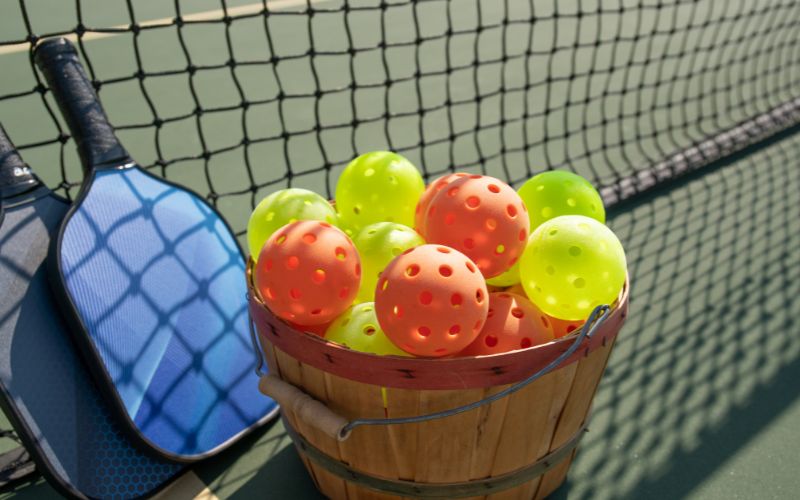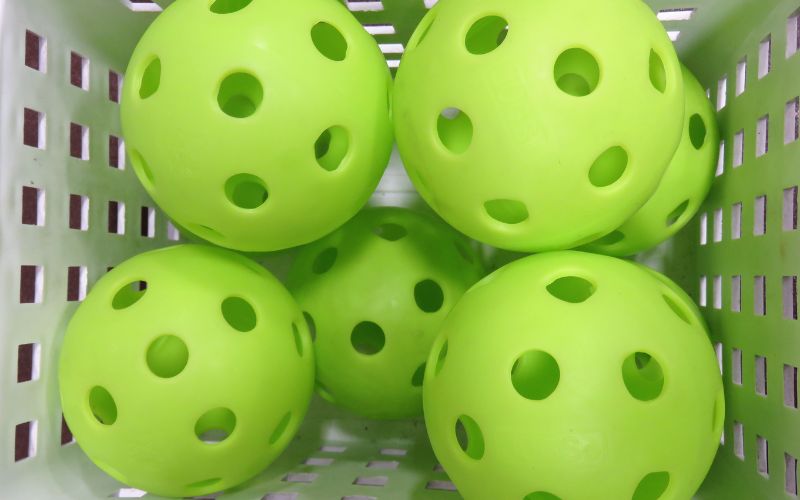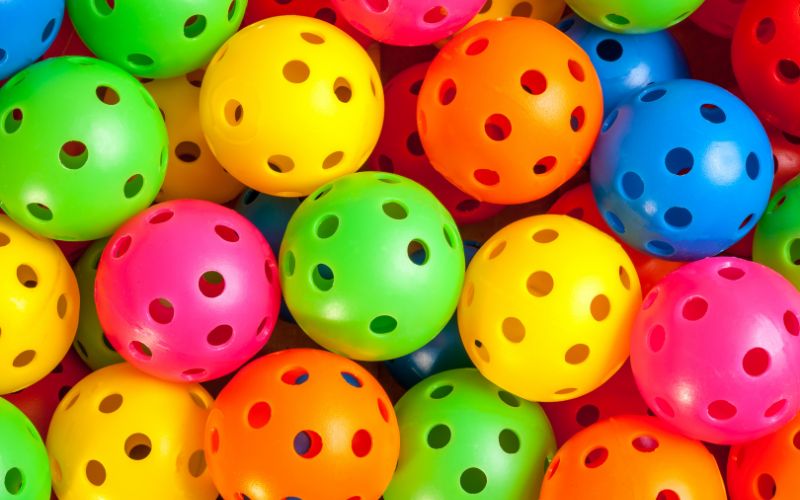Pickleball, a fast-paced and exciting sport, has gained immense popularity in recent years. Whether you’re playing indoors or outdoors, the type of pickleball ball you choose significantly impacts your game. In this comprehensive guide, we will delve into the nuances of indoor and outdoor pickleball balls, exploring the differences, characteristics, and factors to consider when selecting the right ball for your game.
Indoor and Outdoor Pickleballs: Understanding the Basics
Indoor Pickleballs
Indoor pickleballs are specifically designed for playing within the confines of a pickleball court. These balls are tailored to suit the characteristics of indoor play, offering a unique set of features.
Material and Construction
- Indoor balls tend to be slightly lighter.
- They are typically made of a softer plastic material compared to their outdoor counterparts.
- The hole patterns on indoor balls may vary, but they generally have fewer holes than outdoor balls.
Playing Conditions
- Playing indoors provides a controlled environment without external factors like wind interference.
- The court surface is smoother, and the atmosphere is free from weather conditions, allowing for a consistent playing experience.
Flight Trajectory
- Indoor balls are designed for a lower bounce, contributing to a slower pace of play.
- The flight trajectory is influenced by the indoor court’s conditions, creating a more predictable ball movement.
Hole Quantity
Indoor balls typically feature fewer, ranging between 26 and 30.
Hole Diameter
Indoor Pickleballs possess wider holes, providing a distinctive characteristic that contributes to their softer feel, slower pace during play, and enhanced ease of control for players.
Ball Size
Indoor Pickleballs, characterized by their lighter weight, offer players an experience of slower play on the court, promoting enhanced control over the trajectory and direction of the ball.
Hardness
Indoor Pickleballs, distinguished by their softer composition, exhibit increased resilience to cracking, making them a preferred choice for players who prioritize durability and longevity in their equipment.
Outdoor Pickleballs
Outdoor pickleballs, on the other hand, are crafted to withstand the challenges posed by outdoor play. From wind interference to rougher surfaces, these balls are engineered for durability and adaptability.
Material and Construction
- Outdoor pickleballs are made of harder plastic to endure rougher surfaces commonly found in outdoor environments.
- They have a larger number of holes, contributing to their ability to withstand external factors.
Playing Conditions
- Playing outdoors introduces variables like wind, changing weather conditions, and uneven surfaces.
- The larger holes and harder construction allow outdoor balls to handle the impact of rougher outdoor environments.
Flight Trajectory
- Outdoor balls are designed to have a slightly higher bounce, catering to the different playing conditions outdoors.
- The flight trajectory may be affected by wind, making the game more dynamic and challenging.
Hole Quantity
Outdoor pickleballs usually boast a higher number of holes, often nearing the maximum of 40
The increased number of holes in outdoor balls is essential for adapting to erratic winds, ensuring a more consistent and precise flight. These additional holes contribute to a straighter trajectory, minimizing the influence of gusts and crosswinds during your game.
Hole Diameter
Outdoor Pickleballs feature smaller holes, giving them a firmer texture, a faster pace in the game, albeit being slightly harder to control compared to their indoor counterparts.
Ball Size
Outdoor Pickleballs, with their heavier build, provide stability in windy conditions, ensuring a more predictable flight path, although they might be slightly harder to control compared to their indoor counterparts.
Hardness
Outdoor Pickleballs, characterized by their harder construction, facilitate faster play while demonstrating robust resistance to the challenges posed by outdoor elements, ensuring sustained performance in rough conditions.
Key Differences Summarized
To provide a quick reference, let’s summarize the key differences between indoor and outdoor pickleball balls:
Indoor Pickleball Balls
- Softer plastic construction
- Lighter weight
- Fewer, smaller holes
- Lower bounce
- Designed for controlled indoor environments
Outdoor Pickleball Balls
- Harder plastic construction
- Heavier weight
- More, larger holes
- Higher bounce
- Built to withstand outdoor elements
Making the Right Pickleball Ball Choice
Choosing the right pickleball ball enhances your playing experience and contributes to the overall enjoyment of the game. Consider the following tips when making your selection:
1. Assess Your Playing Environment
- Consider whether you primarily play indoors or outdoors.
- Evaluate the characteristics of your usual playing environment, including surface conditions and weather.
2. Understand Your Playing Style
- Reflect on your playing style and preferences.
- If you enjoy a slower, controlled game, indoor balls might be more suitable.
- For those who relish a more dynamic and challenging experience, outdoor balls are the better choice.
3. Experiment with Different Balls
- Don’t hesitate to try out both indoor and outdoor balls to determine your preference.
- Experimenting allows you to assess how each type of ball performs and feels during play.
4. Consider Player Skill Level
- Novice players may find indoor balls more forgiving due to their lower bounce and slower pace.
- Advanced players might appreciate the responsiveness and challenges posed by outdoor balls.
5. Be Mindful of Ball Specifications
- Familiarize yourself with the specifications and regulations set by USA Pickleball regarding ball characteristics.
- Ensure that the chosen ball complies with official standards for sanctioned play.
Conclusion
In the realm of pickleball, the choice between indoor and outdoor balls significantly influences the dynamics of the game. Understanding the nuances of these balls, from their construction to their performance characteristics, empowers players to make informed decisions. Whether you thrive in the controlled environment of indoor play or embrace the challenges of outdoor courts, the right pickleball ball enhances your overall playing experience.
Make your choice wisely, consider the factors that matter most to you, and embark on your pickleball journey with the perfect ball for your game. Enjoy the thrill of the sport, whether you’re playing indoors or venturing into the great outdoors!
Frequently Asked Questions (FAQs)
1. What distinguishes indoor pickleballs from outdoor pickleballs?
Indoor pickleballs are designed for controlled indoor environments, featuring softer plastic, lighter weight, and fewer, wider holes for a slower pace. Outdoor balls, on the other hand, are crafted with harder plastic, more weight, and numerous smaller holes to withstand outdoor conditions.
2. How does the construction of indoor pickleballs impact their performance?
Indoor pickleballs, made of softer plastic, exhibit increased resilience to cracking, providing durability and longevity. The softer composition contributes to a slower pace, lower bounce, and enhanced control during play.
3. What characteristics define outdoor pickleballs?
Outdoor pickleballs are characterized by their harder plastic construction, heavier weight, and more, smaller holes. These features ensure stability in windy conditions, a faster pace of play, and resilience to rough outdoor elements.
4. What factors influence the choice between indoor and outdoor pickleballs?
Consider your playing environment, preferences, and skill level. Indoor balls suit controlled play, offering a slower and more predictable experience. Outdoor balls cater to dynamic play, adapting to external elements for a challenging game.
5. How can players make the right pickleball ball choice?
Assess your usual playing environment, experiment with both ball types, and consider your playing style and skill level. Familiarize yourself with official regulations to ensure your chosen ball complies with USA Pickleball standards, enhancing your overall playing experience.






